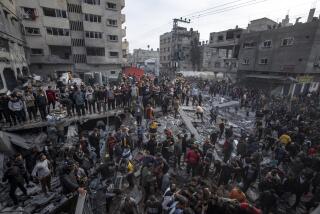Civilian deaths up again in Iraq
- Share via
BAGHDAD — Bombings, sectarian slayings and other violence related to the war killed at least 1,773 Iraqi civilians in August, the second month in a row that civilian deaths have risen, according to government figures obtained Friday.
In July, the civilian death toll was 1,753, and in June it was 1,227. The numbers are based on morgue, hospital and police records and come from officials in the ministries of Health, Defense and the Interior. The statistics appear to indicate that the increase in troops ordered by President Bush this year has done little to curb civilian bloodshed, despite U.S. military statements to the contrary.
Military officials have said the security plan is showing progress because the number of attacks on civilians has decreased and sectarian killings have dropped. The security plan, which began in February, has put an additional 28,500 U.S. troops in Baghdad and other trouble spots.
The commander of U.S. forces in Iraq, Army Gen. David H. Petraeus, is expected to cite such indicators when he presents an assessment of the security plan to Congress this month.
The U.S. military says the numbers it gathers are lower than those provided by Iraqi ministries, but it does not release them. But it has said that the monthly civilian death toll from sectarian killings, which do not include all bombings, has dropped to about 1,000 per month from 1,200 per month early this year.
The latest Iraqi government figures show that from an initial drop in civilian deaths after the president’s plan was launched Feb. 13, deaths quickly climbed back nearly to previous levels.
The numbers indicate that even if the number of attacks has dropped, their lethality may have increased.
In January, the month before the extra troops began arriving, 2,076 Iraqi civilians were killed in violence related to the war, according to Iraqi officials. In February, the first month of the security plan, the number dropped to 1,646. In March, it reached 1,872. April saw 1,500 people killed, and in May the figure rose to 1,949. In June, the month in which the last extra troops arrived in the country, 1,227 people were slain.
Various factors can skew the numbers. Baghdad, usually the most violent part of the country, experienced a four-day curfew in June after the bombing of a key Shiite shrine in Samarra, north of the capital. Other cities also were under curfews, which helped keep violence at bay.
But July and August each saw massive bomb blasts that killed scores of civilians and sent numbers soaring.
The latest statistics will not surprise many Iraqis.
A man who identified himself as Khaldoon, a blacksmith living in the mainly Shiite Muslim area of Hurriya in west Baghdad, said he felt secure there only because Shiite militiamen patrolled the streets. He said his cousin, also Shiite, had been killed recently because he had gone into a Sunni Muslim neighborhood.
“The government keeps on feeding us lies on TV, saying that there is progress in such-and-such place or that the services are getting better in some places, but it’s all propaganda,” said Rana Wajid, a Christian woman living in the mainly Sunni area of Dora, in south Baghdad.
Most Iraqis interviewed recently about their views on the military plan said security would not improve unless the country’s political leaders resolved their differences.
Vali Nasr, a Middle East expert at the Council on Foreign Relations, agreed.
“It is the political impasse that is causing the security problem, and it is the political impasse that has to be solved if there is to be an end to the fighting,” he said.
--
Times staff writers Saif Rasheed and Said Rifai contributed to this report.
More to Read
Sign up for Essential California
The most important California stories and recommendations in your inbox every morning.
You may occasionally receive promotional content from the Los Angeles Times.














